New Mars Forums
You are not logged in.
- Topics: Active | Unanswered
Announcement
#26 2015-03-12 19:34:50
- SpaceNut
- Administrator
- From: New Hampshire
- Registered: 2004-07-22
- Posts: 29,850
Re: Perseverance New 2020 Mars Rover based on MSL
http://atomicinsights.com/rtg-heat-sour … materials/
The two isotopes that have been most frequently used are Pu-238 and Sr-90. Each has their advantages and disadvantages that make them preferable for certain types of applications.
Strontium is not associated with nuclear weapons and has never been called the most deadly element known to man. There is a precedence in the United States for widely licensing small quantities of sealed Sr-90; it is used in some aircraft ice detection systems.
Thats good as that removes the nuclear fear angle that inhibits the typical RTG mission.
Sr-90 is a beta emitter with a 28.1 year half life. A pure sample will supply 0.46 kilowatts/kilogram of thermal power when new, or about 15 percent less than a similar mass of Pu-238.
Additionally, an Sr-90 based RTG will deteriorate about three times as fast as one based on Pu-238; a 20 year old power supply will produce only 61 percent of the initial power output.
Because of the lower energy density, a Sr-90 fuel rod will not get as hot as a Pu-238 rod. A new rod, depending on configuration, might be able to achieve a surface temperature of only 700 to 800 degrees C. This is important because a lower temperature available to the hot junction of a thermocouple will reduce the thermoelectric conversion efficiency of the RTG.
Because of these characteristics, a Sr-90 RTG will be about 50 to 100 percent heavier than a Pu-238 RTG of the same power output. For space based applications, where every payload gram is carefully controlled, this mass difference makes it uneconomical to consider Sr-90.
While we might not want to load a mission for duration it seems ok for a short missions.
Now lets see how hard it is to get from Mars?
Offline
Like button can go here
#27 2015-03-13 08:57:47
- Terraformer
- Member
- From: The Fortunate Isles
- Registered: 2007-08-27
- Posts: 3,988
- Website
Re: Perseverance New 2020 Mars Rover based on MSL
However, being a beta-emitter, we may be able to avoid the need for a thermocouple and just generate electricity directly, which would significantly reduce the mass. Possibly even to the point of being able to use it for a manned base...
Use what is abundant and build to last
Offline
Like button can go here
#28 2015-06-30 21:44:17
- SpaceNut
- Administrator
- From: New Hampshire
- Registered: 2004-07-22
- Posts: 29,850
Re: Perseverance New 2020 Mars Rover based on MSL
Foldable Airplane Could Ride a Cubesat to Mars in 2022
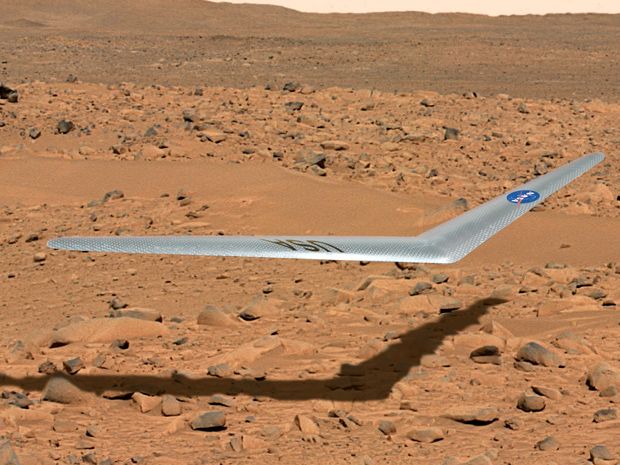
To ensure a safe landing on Mars, a rover inside an aeroshell has to haul along a bunch of ballast to help it orient itself before and after atmospheric entry. This ballast gets jettisoned at two different points in order to control the aeroshell’s center of gravity and attitude, so it’s very important to have along. But, it’s also useless, in that hundreds of kilograms of mass that you’ve hauled all the way from the surface of Earth out to Mars just gets dumped.
http://www.nasa.gov/centers/armstrong/f … plane.html
Prandtl-m would be a small, foldable carbon fiber aircraft that could fit into the volume of a 3U Cubesat—roughly three 10-centimeter cubes stuck together. Deployed, the aircraft would have a 60-centimeter wingspan, and would weigh about half a kilogram. There’d be no engine: the Cubesat unit would be ejected from the aeroshell, survive the atmospheric entry, and then deploy the glider a few thousand feet above the surface of Mars. The glider would soar for about 10 minutes (giving it a range of about 30 kilometers), and then it would, uh, make aggressive contact with the ground.
NASA already has a tester version that’s ready to fly. The larger, non-foldable glider, called Prandtl-d, will be dropped from 30,000 meters by a high altitude balloon later this year. Prandtl-d will simulate the flight conditions its successor will face inside the Martian atmosphere near the surface. The hope is that the glider will be able to stabilize itself and achieve level flight. If that works out, the next step will be to see if they can get a glider to do the same thing—except for starting all folded up inside of a 3U Cubesat container. The final test mission under discussion would involve actual launch in a sounding rocket up to 137,000 meters (450,000 feet), followed by a deployment and controlled glide of up to five hours in length.
“If the Prandtl-m completes a 450,000-foot drop, then I think the project stands a very good chance of being able to go to NASA Headquarters and say we would like permission to ride to Mars with one of the rovers," says Al Bowers, NASA Armstrong chief scientist and Prandtl-m program manager. We can expect that to happen between 2022 and 2024.
Offline
Like button can go here
#29 2015-10-19 19:45:47
- SpaceNut
- Administrator
- From: New Hampshire
- Registered: 2004-07-22
- Posts: 29,850
Re: Perseverance New 2020 Mars Rover based on MSL
Curiosity EDL data to provide 2020 Mars Rover with super landing skills
Lessons learned from the impressive Entry Descent and Landing (EDL) of the Mars Science Laboratory (MSL) are set to provide the next NASA Rover with improved landing skills. The data was collated by the Mars Science Laboratory Entry Descent and Landing Instrument (MEDLI).
MEDLI was provided to Curiosity’s mission by NASA’s Langley and Ames Research Centers. Consisting of two instruments, each with seven sensors, the data during the spacecraft’s high-speed entry into the Martian atmosphere was collected from 14 locations on the spacecraft’s heat shield.
“MEDLI consisted of 7 heat shield pressure ports, 7 integrated sensor plugs, and support electronics. MEDLI gathered engineering data during MSL’s entry and descent for future Mars missions. (This included) aerothermal, aerodynamic, and thermal protection system performance, atmospheric density and winds,”
The results from Curiosity’s dive towards the Martian surface show the 2020 Rover will enjoy the allowance of a lighter Thermal Protection System (TPS). “Reduced required aerothermal environment and TPS design margins Potential 40 percent to 50 percent reduction in forebody TPS thickness, resulting in around 100 kg mass saving.
“Looking down the road, there’s a whole list of topics in technology and precision landing. You would like future crews to say ‘we’re going to land right next to the cargo ship that I landed to previously’. If you’re many kilometers away, that’s not right next to it. You want to be meters away,”

Offline
Like button can go here
#30 2015-10-24 20:26:25
- SpaceNut
- Administrator
- From: New Hampshire
- Registered: 2004-07-22
- Posts: 29,850
Re: Perseverance New 2020 Mars Rover based on MSL
We have been talking about Human missions to Mars and in those we talk about where would we land but that same question is still true for the unmanned missions as well.
Why Return to the Columbia Hills?
This question has come up in some form at virtually every Mars-related meeting this year. The powerful Mars Reconnaissance Orbiter (MRO), with its high-resolution imaging system and mapping spectrometer, has been busy gathering data on nearly 30 candidate landing sites.
To accomplish the habitability investigation, Mars 2020 will need access to a variety of minerals formed in ancient aqueous environments. The geologic diversity present in the tiny 3 by 5 kilometer footprint of the Columbia Hills is astounding: Clays, carbonate minerals, and sulfates all formed in either ancient, long-lasting lakes or in more recent, ephemeral lakes of varying salinity. Rock outcrops made out of nearly pure silica are evidence of an ancient hydrothermal system. Sampling the extensive volcanic basalts present will allow the age of the planet’s surface to be determined.
Offline
Like button can go here
#31 2015-10-25 10:47:06
- GW Johnson
- Member
- From: McGregor, Texas USA
- Registered: 2011-12-04
- Posts: 6,097
- Website
Re: Perseverance New 2020 Mars Rover based on MSL
I hope they do a better design job on the tires than they did with Curiosity.
GW
GW Johnson
McGregor, Texas
"There is nothing as expensive as a dead crew, especially one dead from a bad management decision"
Offline
Like button can go here
#32 2015-12-24 15:03:09
- SpaceNut
- Administrator
- From: New Hampshire
- Registered: 2004-07-22
- Posts: 29,850
Re: Perseverance New 2020 Mars Rover based on MSL
The rovers that landed before used different methods and I am wonder how much different will this lander be?
Here is the ENTRY TRAJECTORY AND ATMOSPHERE RECONSTRUCTION METHODOLOGIES FOR THE MARS EXPLORATION ROVER MISSION
Offline
Like button can go here
#33 2016-01-10 21:59:52
- SpaceNut
- Administrator
- From: New Hampshire
- Registered: 2004-07-22
- Posts: 29,850
Re: Perseverance New 2020 Mars Rover based on MSL
The next rover could slide back in the timeline as a result of the mission that just did not go as it had a leak in a critical system for testing for quakes....
So as to not lose out on data about which the mission is to leverage from here is the msl link http://spaceodyssey.dmns.org/media/5208 … tation.pdf
Offline
Like button can go here
#34 2016-02-10 20:53:45
- SpaceNut
- Administrator
- From: New Hampshire
- Registered: 2004-07-22
- Posts: 29,850
Re: Perseverance New 2020 Mars Rover based on MSL
Offline
Like button can go here
#35 2016-03-18 22:01:03
- SpaceNut
- Administrator
- From: New Hampshire
- Registered: 2004-07-22
- Posts: 29,850
Re: Perseverance New 2020 Mars Rover based on MSL
A bit off topic but here goes as some day these rovers will be driving on roads and not worrying about when the aluminum rims will fail due to becoming brittle. This wil not happen before this rover will be there but one can hope for the future....
Robot-Built Landing Pad Could Pave the Way for Construction on Mars
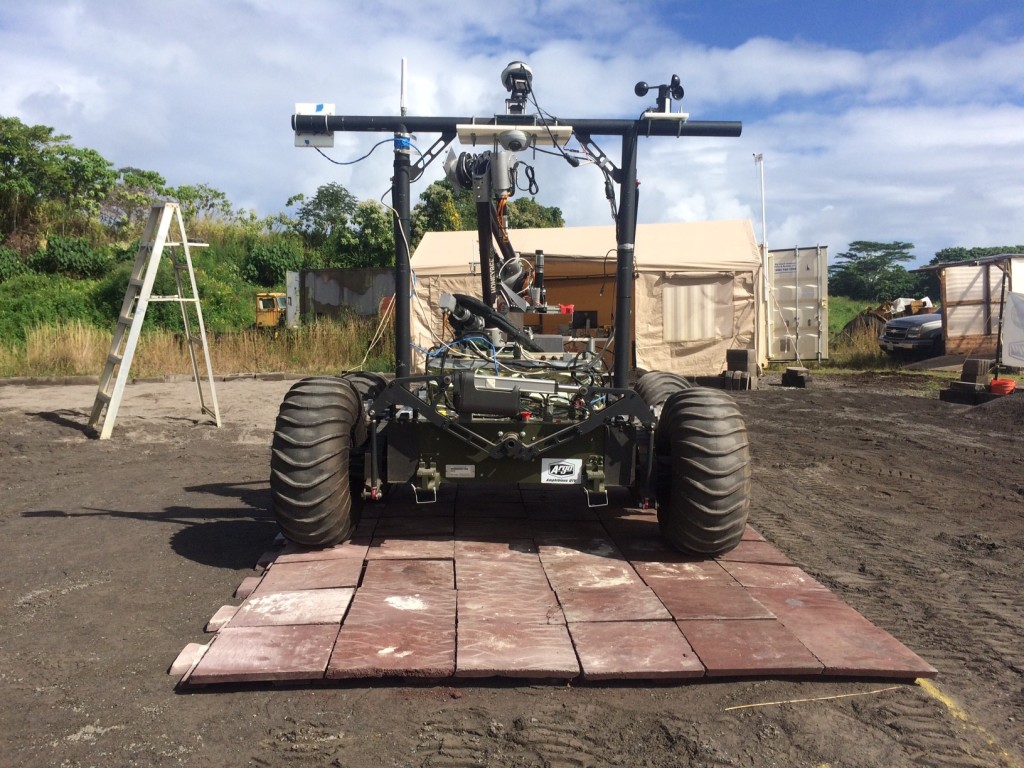
The robotic rover, named Helelani, assembled the pad on Hawaii's Big Island late last year, putting together 100 pavers made of locally available material in an effort to prove out technology that could do similar work in space.
"The construction project is really unique. Instead of concrete for the landing pad, we're using lunar and Mars material, which is exactly like the material we have here on the Big Island.
The rover first worked to clear and grade a 100-square-foot (9.3 square meters) area. Using its robotic arm, the rover then laid out 100 interlocking basalt pavers, which were joined like puzzle pieces to help reinforce the pad.
Helelani was controlled remotely from NASA's Kennedy Space Center in Florida. Time delays were added to the communications to help simulate a lunar or Mars mission, project team members said. The next step will be to test the pad's durability by blasting it with a simulated rocket engine plume, they added.
Offline
Like button can go here
#36 2016-03-20 09:32:40
- SpaceNut
- Administrator
- From: New Hampshire
- Registered: 2004-07-22
- Posts: 29,850
Re: Perseverance New 2020 Mars Rover based on MSL
http://solarsystem.nasa.gov/rps/docs/MM … b_2010.pdf
http://large.stanford.edu/courses/2013/ph241/jiang1/
http://www.digplanet.com/wiki/Multi-Mis … _Generator
International Workshop on Instrumentation for Planetary Missions (2012)
An Overview and Status of NASA’s Radioisotope Power Conversion Technology NRA
Powering Curiosity: Multi-Mission Radioisotope Thermoelectric Generators
The MMRTG is designed to use a heat source composed of eight General Purpose Heat Source (GPHS) modules. The MMRTG contains a total of 4.8 kg (10.6 lb) plutonium dioxide that initially provides approximately 2,000 watts of thermal power and 120 watts of electrical power. The thermoelectric GPHS Module materials have demonstrated extended lifetime and performance capabilities, and are the same as those used for the two Viking spacecraft that landed on Mars in 1976. The MMRTG generator is about 64 cm (25 in) in diameter (fin tip to fin tip) by 66 cm (26 in) long and weighs about 45 kg (94 lb). In addition, the MMRTG is a more flexible modular design capable of meeting the needs of a wider variety of missions as it generates electrical power in smaller increments, slightly above 100 watts. The design goals for the MMRTG include ensuring a high degree of safety, optimizing power levels over a minimum lifetime of 14 years, and minimizing weight.
https://en.wikipedia.org/wiki/Multi-Mis … _Generator
So we should be able to get the electrical output to a higher level as there is another 2000 watts of heat that we could tap into....then again we are Utilizing Radioisotope Power System Waste Heat for Spacecraft Thermal Management
Offline
Like button can go here
#37 2016-07-24 16:40:29
- SpaceNut
- Administrator
- From: New Hampshire
- Registered: 2004-07-22
- Posts: 29,850
Re: Perseverance New 2020 Mars Rover based on MSL
Other features of the rover are starting to come out with details of what wil be finally sent to Mars....
NASA’s Mars 2020 rover ready for final design and construction

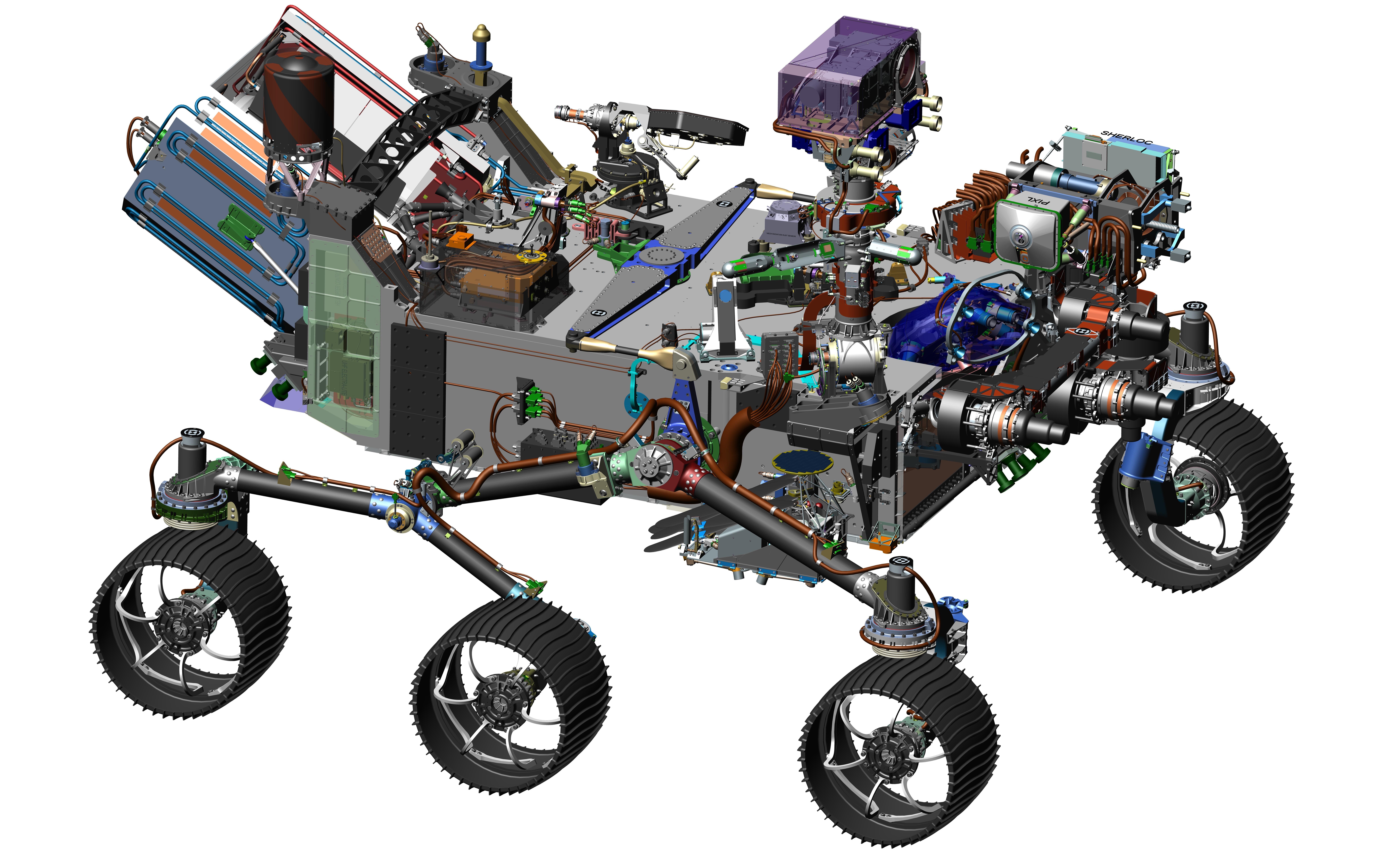
“By adding what’s known as range trigger, we can specify where we want the parachute to open, not just at what velocity we want it to open,” said Allen Chen, Mars 2020 entry, descent, and landing lead at NASA’s Jet Propulsion Laboratory in Pasadena, California. “That shrinks our landing area by nearly half.”
In addition to the range trigger, terrain-relative navigation on the rover will use onboard analysis of downward-looking images taken during the descent, matching them to a map indicating safe and unsafe landing zones.

Offline
Like button can go here
#38 2017-02-13 22:37:13
- SpaceNut
- Administrator
- From: New Hampshire
- Registered: 2004-07-22
- Posts: 29,850
Re: Perseverance New 2020 Mars Rover based on MSL
Landing sites for 2020 Mars rover: NASA weighs 3 options an ancient lake, a past volcanic hotbed and an early hot-spring site.
Scientists chose the final three candidates at a workshop Feb. 8-10 in Monrovia, California, from eight sites chosen in 2015 (out of a pool of around 30, NASA officials said in a statement ).
NASA began its final design and construction phase for Mars 2020 in July of 2016. The rover is intended to hunt for signs of ancient life on the Red Planet after touching down in February 2021, exploring for at least two years, mission team members have said. [NASA's Mars Rover 2020 Mission in Pictures]
The Jezero crater stood out as a forerunner site in 2015, and is among the three remaining potential sites. It's an ancient lakebed where microbial life could have developed, NASA officials said in the statement. The river-delta structure suggests that water filled and drained from the crater at least twice, and NASA's Mars Reconnaissance Orbiter has identified minerals that have been chemically altered by water.
An ancient volcano warmed Northeast Syrtis, and this heat could have led to hot springs and melting ice, making a welcome haven for past microbial life. The edge of the Syrtis Major volcanos is Mars 2020's third potential site. The spot exposes 4-billion-year-old bedrock, as well as many minerals altered by encounters with water during Mars' early history.
The final determination should come after a fourth workshop, likely in 2018, researchers said at the 2015 meeting — or perhaps at a fifth, in 2019, if necessary. The craft itself should launch in July 2020 on an Atlas V rocket from Cape Canaveral, Florida.
Offline
Like button can go here
#39 2017-02-13 22:58:18
Re: Perseverance New 2020 Mars Rover based on MSL
For those who would like to follow the discussion of landing sites in detail, here's a link to the workshop: http://marsnext.jpl.nasa.gov/background.cfm
Also, here's a link to the PowerPoints presented at the workshop. The Jezero PPT is really interesting: http://marsnext.jpl.nasa.gov/workshops/ … 017_02.cfm
Offline
Like button can go here
#40 2017-02-26 11:40:53
- SpaceNut
- Administrator
- From: New Hampshire
- Registered: 2004-07-22
- Posts: 29,850
Re: Perseverance New 2020 Mars Rover based on MSL
The selection of where we are going to land is counting down... Scientists narrow list of landing sites for NASA’s next Mars rover
Now this is an interesting site to land near....

The delta inside Jezero Crater offers one of the best locations on Mars to look for the remains of ancient microbes, according to scientists. Jezero Crater received the most votes during a ranking of potential destinations for NASA’s Mars 2020 rover last week.
So why here:
“We’re looking for a site that’s ancient — around 4 or so billion years old — because that’s when we think Mars had water flowing and a more clement environment,” said Jack Mustard, a professor at Brown University who sits on the Mars landing site selection board. “We need to be able to characterize the habitability of that environment and look for preserved biosignatures. And in addition to the science on the ground, we need to find the right samples to return later.”
The why this site:
Its other chief objectives will be to collect at least 30 test tube-sized core samples for possible retrieval and return to Earth on a future mission, and test a new device to generate oxygen from carbon dioxide in the Martian atmosphere, validating a tool future missions could employ to produce breathable air, water and rocket fuel.
Down to three sites left for where we might go:
Why this place looks like the best place to go to:
Jezero and Northeast Syrtis — about 30 miles (50 kilometers) apart — lie at about 18 degrees north latitude. Neither place has been explored on the surface.
“Jezero Crater tells a story of the on-again, off-again nature of the wet past of Mars,” NASA wrote in a description accompanying the landing site announcement. “Water filled and drained away from the crater on at least two occasions. More than 3.5 billion years ago, river channels spilled over the crater wall and created a lake.”
Imagery obtained from NASA’s Mars Reconnaissance Orbiter show clear evidence of a dried-up river delta that fed a lake. Scientists think the delta deposits, which came from a watershed stretching 4,600 square miles (nearly 12,000 square kilometers), offer one of the best places on Mars to look for preserved organic matter and biomarkers in samples the rover could scoop up and store for return to Earth by a later mission.
“Any organic matter that might have been in that [watershed] is going to get concentrated in an area we can explore with a rover,” said Tim Goudge, a postdoctoral fellow at the University of Texas at Austin who made the case for Jezero Crater.
Offline
Like button can go here
#41 2017-07-17 20:58:23
- SpaceNut
- Administrator
- From: New Hampshire
- Registered: 2004-07-22
- Posts: 29,850
Re: Perseverance New 2020 Mars Rover based on MSL
The future is in turmoil as Nasa has no money it says to do the many great things that it is doing on its way to mars. The future (or lack thereof) of NASA’s Mars Exploration Program its inception in 2000, has enabled the space agency’s leadership to define a coherent scientific and engineering strategy for its robotic Mars missions.
Budget cuts to the Mars Exploration Program in 2009 and 2013 upset the planned mission cadence necessary for progress on the scientific goals outlined in NASA’s strategic plans for the program.
One of the issues with the exploration that is going on is the rate of data being transmitted back to earth i the future will hit its limits....
http://planetary.s3.amazonaws.com/asset … --2017.pdf
The Planetary Society makes three core recommendations:
NASA should immediately commit to a Mars telecommunications and high-resolution imaging orbiter to replace rapidly aging assets currently at Mars.
NASA should enter formulation for a sample retrieval rover and Mars Ascent Vehicle mission to continue the overall Mars Sample Return campaign.
NASA should formulate a follow-on strategy to the Robotic Mars Exploration Strategy, 2007–2016 document.
Offline
Like button can go here
#42 2018-05-12 18:32:56
- SpaceNut
- Administrator
- From: New Hampshire
- Registered: 2004-07-22
- Posts: 29,850
Re: Perseverance New 2020 Mars Rover based on MSL
Reposting as this is going to happen with this mission to mars:
Engineers at JPL began working on the Mars Helicopter in 2013 and spent four years coming up with the final design.
NASA plans to deploy the helicopter for a 30-day flight test campaign with up to five flights covering progressively greater distances. Once there, it will use solar cells to charge its batteries and operate a built-in heater to combat frigid nighttime temperatures.
The will not pilot and Earth will be several light minutes away, so there is no way to joystick this mission in real time which means the helicopter has to fly itself autonomously once it receives its instructions relayed from the rover to it for each flight.
The space agency announced the decision on Friday to add a small helicopter — about four pounds with a fuselage the size of a softball and blades that span just over three and a half feet, tip to tip — to its Mars 2020 mission, which is to launch in July 2020 and arrive at Mars the following February.
A Helicopter on Mars? NASA Wants to Try
The thin air at the surface of Mars is the equivalent of being 100,000 feet above Earth — well beyond the limits of terrestrial helicopters — although the weaker gravity helps. Two pairs of rotor blades will spin in opposite directions at nearly 50 revolutions per second. A prototype has been tested in a chamber that mimics the Martian atmosphere at NASA’s Jet Propulsion Laboratory.
How hard is it to fly a helicopter on Mars? NASA will soon find out

To get airborne, the four blades on the Mars Helicopter will make nearly 3,000 rotations per minute. That means they will spin about 10 times faster than a helicopter built for our skies.
NASA plans to fly the craft up to five times over a span of 30 days. For its maiden voyage, the goal is to hover 10 feet above the ground for about 30 seconds. If all goes well, its final flight will cover a distance of several football fields over a period of 90 seconds.
Offline
Like button can go here
#43 2018-05-13 03:27:17
- louis
- Member
- From: UK
- Registered: 2008-03-24
- Posts: 7,208
Re: Perseverance New 2020 Mars Rover based on MSL
The idea of a Mars helicopter I still find counter-intuitive but those guys know the physics. I guess. But if it is possible that kind of begs the question why NASA haven't been working harder on this, since it would make a huge difference to robot exploration. To my way of thinking this is all rather irrelevant now there is a human mission in full swing. If there is going to be a huge propellant plant as part of the mission then exploration by lightweight robot rocket hoppers makes more sense I think.
Let's Go to Mars...Google on: Fast Track to Mars blogspot.com
Offline
Like button can go here
#44 2018-05-13 08:26:56
- SpaceNut
- Administrator
- From: New Hampshire
- Registered: 2004-07-22
- Posts: 29,850
Re: Perseverance New 2020 Mars Rover based on MSL
Well the topic of the 2020 rover is only 4 years and the article references 5 years ago...which places it in the requests for technology and mission concepts. The money is R&D paper money at that point with no actual hardware.
NASA has selected 12 proposals for study under Phase I of the NASA Innovative Advanced Concepts (NIAC) Program, which aims to turn science fiction into fact.
The selected proposals include a wide range of imaginative concepts, including 3-D printing of biomaterials, such as arrays of cells; using galactic rays to map the insides of asteroids; and an "eternal flight" platform that could hover in Earth's atmosphere, potentially providing better imaging, Wi-Fi, power generation, and other applications.
NIAC Phase I awards are about $100,000 to conduct nine-month initial definition and analysis studies of a concept. If the basic feasibility studies are successful, proposers can apply for Phase II funding as much as $500,000 for two more years of concept maturation.
other stupid concepts of sls https://phys.org/news/2013-07-nasa-inte … irect.html
http://www.unmannedsystemstechnology.co … -concepts/
NIAC studies visionary aerospace architecture, system or mission concepts that are exciting and unexplored, yet credible and executable. The concepts are early in development — generally 10 years or more from operation.
https://phys.org/news/2013-08-nasa-adva … cepts.html
NASA selects 2013 NASA Innovative Advanced Technology Concepts for continued study selected six technology proposals Phase 2 awards can be worth as much as $500,000 for two years
Offline
Like button can go here
#45 2018-07-21 09:59:00
- SpaceNut
- Administrator
- From: New Hampshire
- Registered: 2004-07-22
- Posts: 29,850
Re: Perseverance New 2020 Mars Rover based on MSL
Reposting desire to use the mission in another manner...
If anyone here has any ability to contact Donald Trump, one thing I would like to see is a last minute change of Mars 2020. It's designed as a second copy of Curiosity, so the manufacturer can sell another. It's designed to take samples, then leave them in a coconut size container on the surface of Mars in the hope that a second later rover would retrieve it. Then another mission would deliver a rocket to Mars to launch the sample container to vicinity of the Moon. Then an Orion spacecraft would go fetch it, carry it to the Deep Space Gateway. Analysis would be done on the Gateway, not Earth. This is absurd! Most likely the sample container would be left on Mars, never to be seen again. I want a lander with a smaller rover to collect samples from the immediate vicinity, a rocket contained on that lander with an Earth entry capsule like Genesis or Stardust. The Mars rocket would use ISPP. This would demonstrate ISPP, would do so quickly (launch 2020), and the mission would be self-contained to bring a Mars sample all the way back to Earth. If someone is absurdly afraid of Mars germs, I have to point out Apollo build a sample handling facility at JSC for Lunar samples. It was built with the fear of Moon germs. Of course it turned out the Moon is sterile, the only germs are ones we brought with us. But that sample examination/handling facility is still there and actively maintained; it's where Moon samples are stored. We could use that same facility to examine Mars samples. At least the samples from the robotic Sample Return mission.
Offline
Like button can go here
#46 2018-07-21 13:12:45
- kbd512
- Administrator
- Registered: 2015-01-02
- Posts: 8,342
Re: Perseverance New 2020 Mars Rover based on MSL
Louis,
Marketing hype from SpaceX does not constitute a manned Mars mission. There is no such thing as a LOX/LCH4 plant for Mars. The only experimentation done to date has been done by NASA. If you can find anything that anyone else has built, then post it here.
The most useful type of aerial observation post would be a camera-equipped ballon tethered to the rover. A helicopter is the most technically challenging aerial observation platform imaginable for use on a Mars mission. JPL may be able to make it work, but "horribly complicated" is the most polite characterization of the technology for this use case.
Offline
Like button can go here
#47 2018-07-22 04:52:32
- elderflower
- Member
- Registered: 2016-06-19
- Posts: 1,262
Re: Perseverance New 2020 Mars Rover based on MSL
I examined the possibility of a large helicopter on Mars by scaling from Earth helicopters and making some assumptions about weights. Just to satisfy myself... It just doesn't work. Lift from an enormous rotor was only a couple of thousand Newtons so no payload at all, and very short range.
Maybe a tiny helicopter with only a camera and a radio might work for a short duration, but how will it know how to get home? If it has no home you have a satellite Perhaps it is tethered? If it's tethered why not use a balloon. A bit of zinc powder and a few drops of HCl will fill it through a tubular tether.
Neither a tiny helicopter nor a balloon will be useful in strong winds so means of retaining it in it's home will be needed.
Offline
Like button can go here
#48 2018-07-22 08:04:49
- SpaceNut
- Administrator
- From: New Hampshire
- Registered: 2004-07-22
- Posts: 29,850
Re: Perseverance New 2020 Mars Rover based on MSL
https://sciencing.com/calculate-lift-ro … 80704.html
http://www.heli-chair.com/aerodynamics_101.html
mass, materials and quite possibly a balloon ballast tank with helium to make it more possible.
Batteries, motor and electronics comprise the majority of the mass
Offline
Like button can go here
#49 2018-07-28 19:17:47
- SpaceNut
- Administrator
- From: New Hampshire
- Registered: 2004-07-22
- Posts: 29,850
Re: Perseverance New 2020 Mars Rover based on MSL
Have been looking at the skycrane for possible landing of human missions and while trying to nail down the specifications for the unit came across this article.

Mars 2020 rover receives upgraded eyesight for tricky skycrane landing
The ability to see that landing adds another layer of safety and risk reduction to the landing.
According to NASA, the agency first tested the new vision system for Mars 2020 on 9 December 2014 via a Masten Space Systems built rocket in Mojave, California.
Overseen by the Jet Propulsion Laboratory (JPL) in Pasadena, California, the Lander Vision System (LVS) – a prototype vision system to the one that will be used on Mars 2020 – launched 324.9 meters (1,066 feet) into the air and helped guide the rocket to a precise landing at a predesignated target.
In all, the LVS is a camera-based navigation system which photographs the terrain beneath a descending spacecraft and matches it with onboard maps.
This allows the landing spacecraft to detect its location relative to landing hazards such as boulders and outcroppings.
The 2020 is not just another redux but will have 5 items that are being tried on this rover.

Offline
Like button can go here
#50 2018-07-29 08:33:20
- SpaceNut
- Administrator
- From: New Hampshire
- Registered: 2004-07-22
- Posts: 29,850
Re: Perseverance New 2020 Mars Rover based on MSL
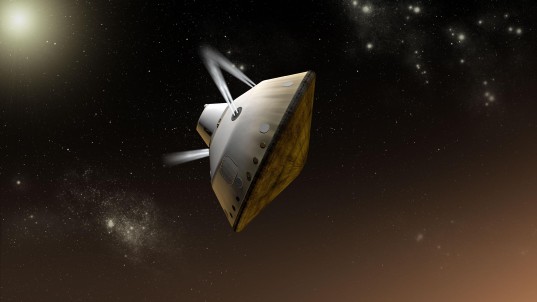
Curiosity fires thrusters during the guided entry phase of its arrival at Mars. With its heat shield nose tilted upward 20 degress with respect to its direction of motion, it actually flies in Mars' atmosphere, banking in S turns to aim it at a target position and velocity for parachute deployment.
How Curiosity Will Land on Mars part 1: Entry
Those previous landers entered ballistically; their fat cone-shaped heat shields were pointed with the tip of the cone in the direction of their motion, they spun around their symmetry axes, and their paths were controlled by the whim of Mars' atmosphere. Winds, areas of less dense or more dense air, and other atmospheric variability affected the rate of those spacecraft's descent. So those craft could land anywhere in a fairly large region, a skinny oval more than 100 kilometers long, landing short if the atmosphere braked them quickly or long if the atmosphere decelerated them more slowly. (In fact, every previous Mars lander landed "long.")
To prepare for its very different, non-ballistic atmospheric entry, Curiosity will despin, slowing from 2 revolutions per minute to halt at a specific orientation, in a condition that navigators call "three-axis stabilized." The spacecraft will then rotate to point the tip of its blunt heat shield "nose" in the direction of its travel. Five minutes before entry, it will jettison two 75-kilogram tungsten "balance masses" from one side of the capsule, shifting its center of gravity off-center. This will tip the nose downward by about 20 degrees, a tilt it will maintain (give or take a couple of degrees) through most of the entry phase. Atmospheric entry is defined as the moment that the spacecraft reaches an altitude of 3522.2 kilometers from the center of Mars -- about 125 kilometers above Mars' average, but closer to 131 kilometers above the landing site, which is at very low elevation. Remember this low-elevation detail -- I'll have something to say about that at the end of this post.
It has a relatively high entry velocity of 5.9 kilometers per second. Just 80 seconds after passing through that entry interface altitude, the surface of the heat shield it reaches its peak temperature of about 2100 degrees Celsius. The heat shield has done its job when the spacecraft slows to about Mach 2.0. The supersonic parachute cannot be opened at higher than Mach 2.2. When it has flown to its target altitude, position, and velocity for parachute deployment, the spacecraft ejects six 25-kilogram masses on the opposite side of the spacecraft from the previous ejected masses, rebalancing it.
The spacecraft also rotates 180 degrees at this point to aim its ground-sensing radar properly. If you're keeping score, that's 300 kilograms of dead weight that the spacecraft brought to Mars and dropped on the way to the ground! This new entry method was needed for two things. One was to shrink the size of the landing ellipse. That opened up more possible landing sites, because it's hard to find places that are flat and safe for landing that are 150 kilometers wide. Only 25 kilometers wide is much easier; and with Curiosity's driving capability, it was expected to be able to rove out of the ellipse to go to interesting rocks in landscapes too dangerous for landing.
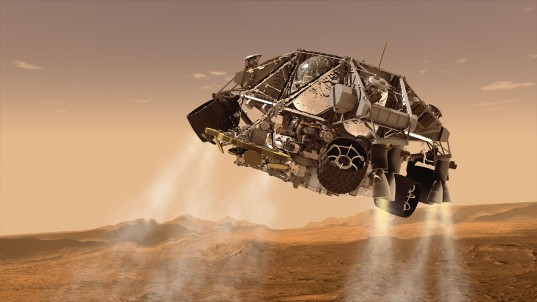
How Curiosity Will Land on Mars, Part 2: Descent
Curiosity's parachute will be the largest ever opened on Mars, at 21.5 meters across, compared to Viking's 16.5 meters, Spirit and Opportunity's 14.1 meters, Pathfinder's 12.7 meters, and Phoenix' 11.8 meters.
The parachute descent phase lasts only 50 to 90 seconds (depending on atmospheric conditions). But during this brief time, according to this paper by the rover engineering team, "the parachute system acts to burn over 95% of the remaining kinetic energy it had descended to about 11,000 meters and decelerated to Mach 2.0 or roughly 450 meters per second. Slowing to that velocity -- still supersonic -- triggers the deployment of the parachute, which is only qualified up to Mach 2.2. If the huge parachute does its job, it will take less than 30 seconds to decelerate the spacecraft to subsonic speeds.
The next step in the process comes when the spacecraft has slowed to about 80 meters per second, at an altitude somewhere around 1.5 kilometers. At 100 meters per second and 1500 to 2000 meters altitude, the spacecraft is ready to initiate the next step: powered descent. It prepares by opening the fuel lines to the 8 descent thrusters on its jetpack (otherwise known as the descent stage), and commanding them to 1% throttle.
Pyros fire to separate the descent stage from the backshell and parachute. Suddenly lacking any means of slowing down, the spacecraft free-falls, accelerating toward the ground under Martian gravity for one heart-stopping second, speeding up from 100 to 120 meters per second. The rover will calmly descend at 20 meters per second until its terminal descent sensors tell it that it has reached an altitude of 50 meters. Then the thrusters are throttled up again to decelerate the descent at a constant rate until it's reached a rate of 0.75 meters per second; it continues this descent rate for the rest of the landing.
By the time it gets to an altitude of 21 meters, the descent stage will have burned through more than half of its 400 kilograms of fuel. If the rockets kept thrusting at a constant rate, they'd actually lift the rover upward. They have to be throttled back so much that they start to operate inefficiently. So four of the eight engines are shut down, allowing the four remaining engines to operate in a better zone (at around 50% of their full power).
First: Curiosity is huge, nearly five times the mass of Spirit or Opportunity. It's half again larger than a Viking lander. A Mars Exploration Rover weighs 185 kilograms; to get that 185 kilograms of rover safely to the ground required a protective enclosure of a lander weighing in at 348 kilograms. Of all that 533 kilograms of landed mass, only 5 kilograms -- less than 1%! -- were science instruments.
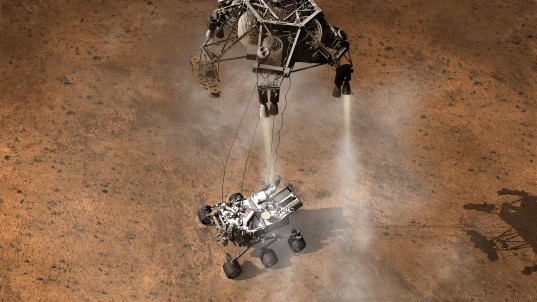
How Curiosity Will Land on Mars, Part 3: Skycrane and Landing
There are five main steps in the skycrane maneuver: 1) separate the hard connection between the rocket-powered descent stage and the rover; 2) deploy the rover's landing gear (that is, its legs and wheels); 3) deposit the rover very gently on the surface; 4) sever the soft connection between the descent stage and the rover; and 5) fly the descent stage far away where its fuel can't do the rover and its instruments any harm, and won't contaminate the landing site.
The descent stage holds a constant altitude for 187 milliseconds, allowing time for the umbilical to be cut, then throttles up the rockets, ascending vertically at first but then pitching to 45 degrees. Free of the rover's weight, the descent stage flies off. Originally, it was going to burn to depletion; but at some point they changed that plan, commanding it instead to burn for a fixed time. Then the rockets cut off, and the descent stage (and any remaining fuel) crash at least 150 meters away.
Offline
Like button can go here
